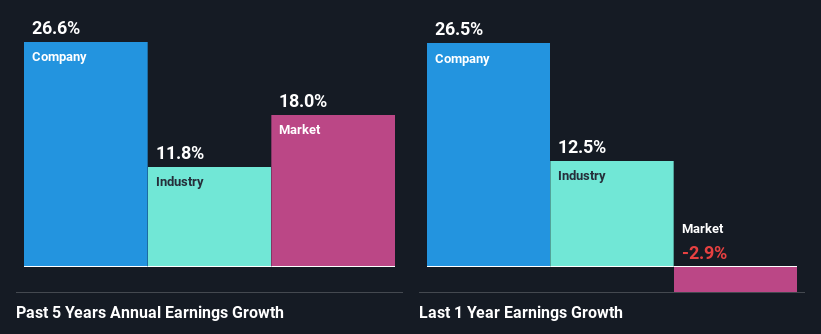Will Weakness in Comelf S.A.'s (BVB:CMF) Stock Prove Temporary Given Strong Fundamentals?

It is hard to get excited after looking at Comelf's (BVB:CMF) recent performance, when its stock has declined 13% over the past three months. However, a closer look at its sound financials might cause you to think again. Given that fundamentals usually drive long-term market outcomes, the company is worth looking at. In this article, we decided to focus on Comelf's ROE.
ROE or return on equity is a useful tool to assess how effectively a company can generate returns on the investment it received from its shareholders. Simply put, it is used to assess the profitability of a company in relation to its equity capital.
See our latest analysis for Comelf
How Do You Calculate Return On Equity?
Return on equity can be calculated by using the formula:
Return on Equity = Net Profit (from continuing operations) ÷ Shareholders' Equity
So, based on the above formula, the ROE for Comelf is:
9.8% = RON8.2m ÷ RON84m (Based on the trailing twelve months to March 2024).
The 'return' is the yearly profit. One way to conceptualize this is that for each RON1 of shareholders' capital it has, the company made RON0.10 in profit.
Why Is ROE Important For Earnings Growth?
Thus far, we have learned that ROE measures how efficiently a company is generating its profits. Depending on how much of these profits the company reinvests or "retains", and how effectively it does so, we are then able to assess a company’s earnings growth potential. Assuming all else is equal, companies that have both a higher return on equity and higher profit retention are usually the ones that have a higher growth rate when compared to companies that don't have the same features.
A Side By Side comparison of Comelf's Earnings Growth And 9.8% ROE
At first glance, Comelf's ROE doesn't look very promising. However, the fact that the its ROE is quite higher to the industry average of 4.3% doesn't go unnoticed by us. Particularly, the substantial 27% net income growth seen by Comelf over the past five years is impressive . Bear in mind, the company does have a moderately low ROE. It is just that the industry ROE is lower. Therefore, the growth in earnings could also be the result of other factors. For example, it is possible that the broader industry is going through a high growth phase, or that the company has a low payout ratio.
Next, on comparing with the industry net income growth, we found that Comelf's growth is quite high when compared to the industry average growth of 12% in the same period, which is great to see.

Earnings growth is a huge factor in stock valuation. What investors need to determine next is if the expected earnings growth, or the lack of it, is already built into the share price. By doing so, they will have an idea if the stock is headed into clear blue waters or if swampy waters await. If you're wondering about Comelf's's valuation, check out this gauge of its price-to-earnings ratio, as compared to its industry.
Is Comelf Using Its Retained Earnings Effectively?
Comelf has a three-year median payout ratio of 44% (where it is retaining 56% of its income) which is not too low or not too high. By the looks of it, the dividend is well covered and Comelf is reinvesting its profits efficiently as evidenced by its exceptional growth which we discussed above.
Additionally, Comelf has paid dividends over a period of nine years which means that the company is pretty serious about sharing its profits with shareholders.
Conclusion
On the whole, we feel that Comelf's performance has been quite good. Particularly, we like that the company is reinvesting heavily into its business at a moderate rate of return. Unsurprisingly, this has led to an impressive earnings growth. If the company continues to grow its earnings the way it has, that could have a positive impact on its share price given how earnings per share influence long-term share prices. Remember, the price of a stock is also dependent on the perceived risk. Therefore investors must keep themselves informed about the risks involved before investing in any company. To know the 3 risks we have identified for Comelf visit our risks dashboard for free.
New: AI Stock Screener & Alerts
Our new AI Stock Screener scans the market every day to uncover opportunities.
• Dividend Powerhouses (3%+ Yield)
• Undervalued Small Caps with Insider Buying
• High growth Tech and AI Companies
Or build your own from over 50 metrics.
Have feedback on this article? Concerned about the content? Get in touch with us directly. Alternatively, email editorial-team (at) simplywallst.com.
This article by Simply Wall St is general in nature. We provide commentary based on historical data and analyst forecasts only using an unbiased methodology and our articles are not intended to be financial advice. It does not constitute a recommendation to buy or sell any stock, and does not take account of your objectives, or your financial situation. We aim to bring you long-term focused analysis driven by fundamental data. Note that our analysis may not factor in the latest price-sensitive company announcements or qualitative material. Simply Wall St has no position in any stocks mentioned.
About BVB:CMF
Comelf
Manufactures and sells engines and turbines in Romania and internationally.
Flawless balance sheet with solid track record.


